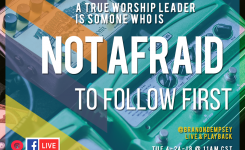Leaders, Songwriting, WTTU Special Public Post
“Creative Music Arranging” (Show #132) | 8-8-17
 #ChordStory
#ChordStory
2 min read | 30m Show
The Trouble With Chords
Worship Leaders, do you struggle coming up with fresh arrangements of your favorite worship songs? Do you want to come with your own version of a song that is not just a copy, but not quite sure where to start?
It is possible to take a great melody and come up with a whole new sound just by creatively using different chord structures that support that melody. It just takes some creativity and a basic knowledge of chord structure and music arranging.
Learn how to move away from using the same four basic chords for a song, and dive deep into music theory with this article about creative music arranging.
It is possible to take a great melody and come up with a whole new sound just by creatively using different chord structures that support that melody. It just takes some creativity and a basic knowledge of chord structure and music arranging.
Learn how to move away from using the same four basic chords for a song, and dive deep into music theory with this article about creative music arranging.
8-8-17 WATCH SHOW #132 (The Ministry Behind the Music)
Also Watch Live by: FacebookLive or Periscope
Chord Exploration
Alright, folks. I’m just going to say it. We have a chord problem. We need to push the creative bounds of our chord progressions in worship music. In fact, this applies to the Christian music industry in general. To be clear, this article series is a pep talk for me too. I get stuck in chord progression ruts all the time, and I have a bad habit of settling into comfortable routines, whether in songwriting or in live worship services. Yet when I realize the problem and go out of my way to try something risky and new, it leads to real growth as a musician. The goal of this article is not to present some perfectly comprehensive treatment of the topic of chords, but it will give you some ideas to explore when you’re writing a new worship song or playing in a worship service.
The Art of Cadence
In the classic hymn “Amazing Grace” you can hear the melody resolve on what’s called a “perfect authentic cadence” at the end of each lyrical phrase—or, as I like to call it, a perfect AWESOME cadence. A cadence, in short, is when the music expresses a powerful sense of harmonic resolution—a release of tension—like a sigh of relief you breathe when you finish a tough job. Music theorists came up with the word “cadence” to refer to these moments. More specifically, a perfect authentic cadence happens when you go from a five chord to a one chord. For example, in “Amazing Grace”, at the end of the first stanza, you hear a chord change on the word “now” in the line “Was blind, but now I see,” and it resolves into another chord on “see,” and you feel that musical sigh of relief. That was a five chord moving to a one chord—a perfect AWESOME cadence.
If the key is D major, for example, it’s an A major chord (the fifth chord in the D major scale) going to a D major chord (the first chord in the D major scale). Every worship song ever written has this cadence or something close to it. All of Western music relies on this pleasing tension-release phenomenon—from Mozart to Rihanna.
However, instead of always doing this predictable five to one chord resolution, try these chord substitutions to spice things up:
[ctt template=”6″ link=”7Pl1I” via=”no” ] Use chord substitutions to spice things up[/ctt]
The Decepticon Cadence
In music theory, this is actually called a deceptive cadence; but my enjoyment of Transformers in general made it impossible not to change its name to “The Decepticon Cadence.” Composers named it “deceptive” because it sets the listener up to expect a normal V-I resolution, but then it takes a sudden twist into the minor realm by playing a V-vi combination.If you used the song Amazing Grace as the guinea pig, instead of playing the D major chord on the word “see” in that first stanza, you would play a B minor, which is the sixth chord (symbol “vi”) in the D major key (i.e. B is six notes up from D).
When you’re writing a song, this is an interesting way to take the music in an unexpected direction just as you begin to hear the tension-release of a cadence coming, usually at the end of a lyrical or melodic idea. You can also use this deceptive cadence to alter popular songs you play in the worship service and add a new twist to them.
The Jazz Hands Cadence
Yes, this is another name I invented, but, hey, it makes it easy to remember. This next twist on cadences hails from the jazz world. It’s a fun and easy trick to remember, whether you’re writing a new song, arranging an old one, or leading worship from your acoustic guitar or solo piano and want to freshen up your chord progression. Similar to the Decepticon Cadence, instead of doing the typical V-I combo, you go from V to VIb7, and then to the one chord. In Amazing Grace, for example, at the end of each stanza, instead of going from A major to D major, you would go from A major to Bb7 to D major. This cadence works particularly well for faster songs.The Half-Diminished Cadence
For some reason, the sound of this altered cadence reminds me of someone lost in thought, pondering a difficult or wonderful idea. It adds an unexpected, melancholic depth to the music, and it encourages contemplation among those who hear it. It works particularly well for slow songs.To execute this cadence, you throw out the V chord altogether. So, once again using “Amazing Grace” as our guinea pig, instead of playing A major in the cadence at the end of each stanza, you would play a half-diminished seventh chord (m7b5).
To see a chord-fingering chart for the m7b5 shape, click here. The most common use of this cadence is with the vii chord (or seven chord). For example, in D major, the seventh note in the scale would be a C#, so the cadence progression would be C#m7b5 to D major.
However, there’s yet another half-diminished cadence that I like even more. I stumbled across it while playing 1950s bossa nova jazz. Of course, that is not the only place it is found, but whenever I play this chord, I hear the haunting Brazilian guitar of Gil Gilberto and the quiet voice of his wife Astrud. It still uses the m7b5 shape, but instead of the “vii” chord (C# in the key of D major), it uses a flatted “ii” chord—the Ebm7b5 (chord fingering here). In this cadence, you would therefore toss out the A major chord and instead play Ebm7b5 to D major. Using this classic hymn that everyone knows was just for demonstration.
Try using these cadences in a wide variety of songs and styles; you’ll be surprised what you find. Also keep in mind that my examples above in D major can be transferred into any key by identifying the one chord and the five chord of that particular key. In C major, for example, the one chord would be C, and the five chord would be G (five notes up from one).
Creative Work
Rearranging your songs to utilize these new chord progressions will take some work, but in the end, it will be worth it. Surprise your band and your congregation with some new arrangements of familiar songs and hymns. It might just catch their attention, and cause them to listen with new ears to the familiar songs of the faith.@KevinOttAuthor @BranonDempsey @worshiptt @WorshipTTU
Want to watch MORE Worship Team Training Videos?
Not a WTTU Member, or Choose to Upgrade? Update Now

Worship Team Training® Is your worship team stuck? Want worship leading to be better? Want to be free? We can take you there. Inspire, create and transform the leading of worship. Get a WeekendWorkshop
Copyright 2017 Worship Team Training®










1 Comment
Gord Evans
I enjoyed today’s webinar, and I love Kim’s wonderful and vibrant spirit. Very encouraging!
But, what happened to the scheduled webinar on chords?
I read through the material and was looking forward to that discussion. Will it take place at another time, Branon?